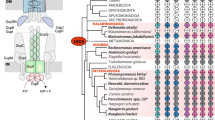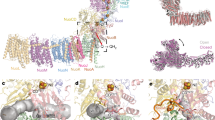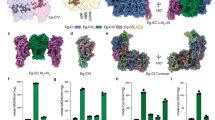Abstract
Trichomonas vaginalis is a unicellular microaerophilic eukaryote that lacks mitochondria yet contains an alternative organelle, the hydrogenosome, involved in pyruvate metabolism. Pathways between the two organelles differ substantially: in hydrogenosomes, pyruvate oxidation is catalysed by pyruvate:ferredoxin oxidoreductase (PFOR), with electrons donated to an [Fe]-hydrogenase which produces hydrogen. ATP is generated exclusively by substrate-level phosphorylation in hydrogenosomes, as opposed to oxidative phosphorylation in mitochondria1. PFOR and hydrogenase are found in eubacteria and amitochondriate eukaryotes, but not in typical mitochondria2,3,4. Analyses of mitochondrial genomes indicate that mitochondria have a single endosymbiotic origin from an α-proteobacterial-type progenitor5. The absence of a genome in trichomonad hydrogenosomes6 precludes such comparisons, leaving the endosymbiotic history of this organelle unclear7. Although phylogenetic reconstructions of a few proteins indicate that trichomonad hydrogenosomes share a common origin with mitochondria8,9,10,11, others do not2,3,4,7. Here we describe a novel NADH dehydrogenase module of respiratory complex I that is coupled to the central hydrogenosomal fermentative pathway to form a hydrogenosomal oxidoreductase complex that seems to function independently of quinones. Phylogenetic analyses of hydrogenosomal complex I-like proteins Ndh51 and Ndh24 reveal that neither has a common origin with mitochondrial homologues. These studies argue against a vertical origin of trichomonad hydrogenosomes from the proto-mitochondrial endosymbiont.
This is a preview of subscription content, access via your institution
Access options
Subscribe to this journal
Receive 51 print issues and online access
$199.00 per year
only $3.90 per issue
Buy this article
- Purchase on Springer Link
- Instant access to full article PDF
Prices may be subject to local taxes which are calculated during checkout




Similar content being viewed by others
References
Müller, M. The hydrogenosome. J. Gen. Microbiol. 139, 2879–2889 (1993)
Horner, D. S., Hirt, R. P. & Embley, T. M. A single eubacterial origin of eukaryotic pyruvate: ferredoxin oxidoreductase genes: implications for the evolution of anaerobic eukaryotes. Mol. Biol. Evol. 16, 1280–1291 (1999)
Horner, D. S., Foster, P. G. & Embley, T. M. Iron hydrogenases and the evolution of anaerobic eukaryotes. Mol. Biol. Evol. 17, 1695–1709 (2000)
Embley, T. M., van der Giezen, M., Horner, D. S., Dyal, P. L. & Foster, P. Mitochondria and hydrogenosomes are two forms of the same fundamental organelle. Phil. Trans. R. Soc. Lond. B 358, 191–201 (2003)
Gray, M. W., Burger, G. & Lang, B. F. Mitochondrial evolution. Science 283, 1476–1481 (1999)
Clemens, D. L. & Johnson, P. J. Failure to detect DNA in hydrogenosomes of Trichomonas vaginalis by nick translation and immunomicroscopy. Mol. Biochem. Parasitol. 106, 307–313 (2000)
Dyall, S. D., Brown, M. T. & Johnson, P. J. Ancient invasions: from endosymbionts to organelles. Science 304, 253–257 (2004)
Bui, E. T. N., Bradley, P. J. & Johnson, P. J. A common evolutionary origin for mitochondria and hydrogenosomes. Proc. Natl Acad. Sci. USA 93, 9651–9656 (1996)
Horner, D. S., Hirt, R. P., Kilvington, S., Lloyd, D. & Embley, T. M. Molecular data suggest an early acquisition of the mitochondrion endosymbiont. Proc. R. Soc. Lond. B 263, 1053–1059 (1996)
Roger, A. J., Clark, C. G. & Doolittle, W. F. A possible mitochondrial gene in the early-branching amitochondriate protist Trichomonas vaginalis. Proc. Natl Acad. Sci. USA 93, 14618–14622 (1996)
Dyall, S. D. et al. Presence of a member of the mitochondrial carrier family in hydrogenosomes: conservation of membrane-targeting pathways between hydrogenosomes and mitochondria. Mol. Cell. Biol. 20, 2488–2497 (2000)
Friedrich, T. & Bottcher, B. The gross structure of the respiratory complex I: a Lego System. Biochim. Biophys. Acta 1608, 1–9 (2004)
Fearnley, I. M. & Walker, J. E. Conservation of sequences of subunits of mitochondrial complex I and their relationships with other proteins. Biochim. Biophys. Acta 1140, 105–134 (1992)
Yano, T., Sled, V. D., Ohnishi, T. & Yagi, T. Identification of amino acid residues associated with the [2Fe–2S] cluster of the 25 kDa (NQO2) subunit of the proton-translocating NADH-quinone oxidoreductase of Paracoccus denitrificans. FEBS Lett. 354, 160–164 (1994)
Yano, T., Sled, V. D., Ohnishi, T. & Yagi, T. Expression and characterization of the flavoprotein subcomplex composed of 50-kDa (NQO1) and 25-kDa (NQO2) subunits of the proton-translocating NADH-quinone oxidoreductase of Paracoccus denitrificans. J. Biol. Chem. 271, 5907–5913 (1996)
Hrdy, I. & Müller, M. Primary structure of the hydrogenosomal malic enzyme of Trichomonas vaginalis and its relationship to homologous enzymes. J. Eukaryot. Microbiol. 2, 593–603 (1995)
Hrdy, I. & Müller, M. Primary structure and eubacterial relationships of the pyruvate:ferredoxin oxidoreductase of the amitochondriate eukaryote Trichomonas vaginalis. J. Mol. Evol. 41, 388–396 (1995)
Dolezal, P., Vanacova, S., Tachezy, J. & Hrdy, I. Malic enzymes of Trichomonas vaginalis: two enzyme families, two distinct origins. Gene 329, 81–92 (2004)
Jonassen, T., Davis, D. E., Larsen, P. L. & Clarke, C. F. Reproductive fitness and quinone content of Caenorhabditis elegans clk-1 mutants fed coenzyme Q isoforms of varying length. J. Biol. Chem. 278, 51735–51742 (2003)
Meganathan, R. Ubiquinone biosynthesis in microorganisms. FEMS Microbiol. Lett. 203, 131–139 (2001)
Massanz, C., Schmidt, S. & Friedrich, B. Subforms and in vitro reconstitution of the NAD-reducing hydrogenase of Alcaligenes eutrophus. J. Bacteriol. 180, 1023–1029 (1998)
Land, K. M. et al. Targeted gene replacement of a ferredoxin gene in Trichomonas vaginalis does not lead to metronidazole resistance. Mol. Microbiol. 51, 115–122 (2004)
Friedrich, T. & Scheide, D. The respiratory complex I of bacteria, archaea and eukarya and its module common with membrane-bound multisubunit hydrogenases. FEBS Lett. 479, 1–5 (2000)
Lang, B. F. et al. An ancestral mitochondrial DNA resembling a eubacterial genome in miniature. Nature 387, 493–497 (1997)
Andersson, S. G. et al. The genome sequence of Rickettsia prowazekii and the origin of mitochondria. Nature 396, 133–140 (1998)
Akhmanova, A. et al. A hydrogenosome with a genome. Nature 396, 527–528 (1998)
Doolittle, W. F. et al. How big is the iceberg of which organellar genes in nuclear genomes are but the tip? Phil. Trans. R. Soc. Lond. B 358, 39–57 (2003)
Martin, W. & Müller, M. The hydrogen hypothesis for the first eukaryote. Nature 392, 37–41 (1998)
Doolittle, W. F. You are what you eat: a gene transfer ratchet could account for bacterial genes in eukaryotic nuclear genomes. Trends Genet. 14, 307–311 (1998)
Huelsenbeck, J. P. & Ronquist, F. MRBAYES: Bayesian inference of phylogenetic trees. Bioinformatics 17, 754–755 (2001)
Acknowledgements
We thank J. L. Kerwin for mass spectrometric analyses. Preliminary T. vaginalis genome sequence data were obtained from TIGR through the website at http://www.tigr.org. Sequencing of the T. vaginalis genome was accomplished with support from the NIH. This work was supported by National Institute of Health (NIH) grants (P.J.J. and C.F.C.) and a National Aeronautics and Space Administration Astrobiology grant to UCLA. P.J.J. is a Burroughs Wellcome Scholar in Molecular Parasitology. The UCLA Mass Spectrometry and Proteomics Technology Center (J.A.L.) was established with a grant from the W. M. Keck Foundation.
Author information
Authors and Affiliations
Corresponding author
Ethics declarations
Competing interests
The authors declare that they have no competing financial interests.
Supplementary information
Supplementary Figure 1
Alignment of T. vaginalis malic enzyme subunits Mae A, B, G, H using CLUSTALW. (DOC 34 kb)
Supplementary Figure 2
Reconstruction of NuoE phylogeny excluding highly divergent sequences. This phylogenetic reconstruction of NuoE sequences shows that the position of T. vaginalis Ndh24 is not due to a long-branch artefact. (JPG 93 kb)
Supplementary Table 1
Primer sequences used in study. (DOC 27 kb)
Supplementary Table 2
List of sequences used to reconstruct Ndh51 phylogeny, with names and accession numbers. (DOC 61 kb)
Supplementary Table 3
List of sequences used to reconstruct Ndh24 phylogeny, with names and accession numbers. (DOC 53 kb)
Rights and permissions
About this article
Cite this article
Dyall, S., Yan, W., Delgadillo-Correa, M. et al. Non-mitochondrial complex I proteins in a hydrogenosomal oxidoreductase complex. Nature 431, 1103–1107 (2004). https://doi.org/10.1038/nature02990
Received:
Accepted:
Issue Date:
DOI: https://doi.org/10.1038/nature02990
This article is cited by
-
The prevalence and genetic characterisation of Cryptosporidium isolates from cattle in Kiruhura district, South Western Uganda
Journal of Parasitic Diseases (2021)
-
Alpha proteobacterial ancestry of the [Fe-Fe]-hydrogenases in anaerobic eukaryotes
Biology Direct (2016)
-
Association between Chloroplast and Mitochondrial DNA sequences in Chinese Prunus genotypes (Prunus persica, Prunus domestica, and Prunus avium)
BMC Plant Biology (2015)
Comments
By submitting a comment you agree to abide by our Terms and Community Guidelines. If you find something abusive or that does not comply with our terms or guidelines please flag it as inappropriate.



